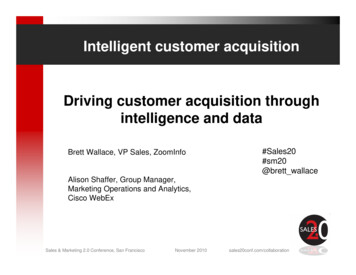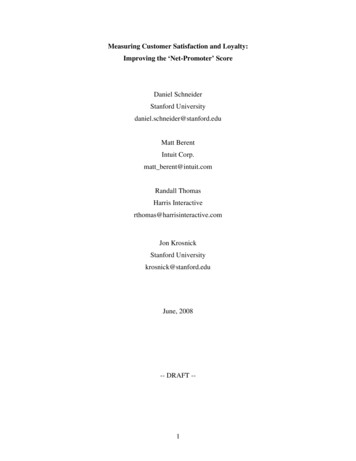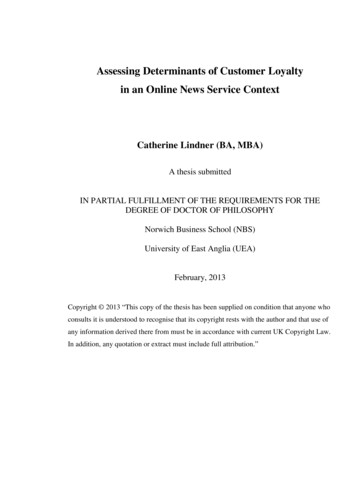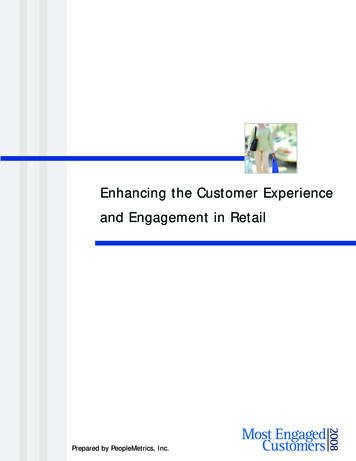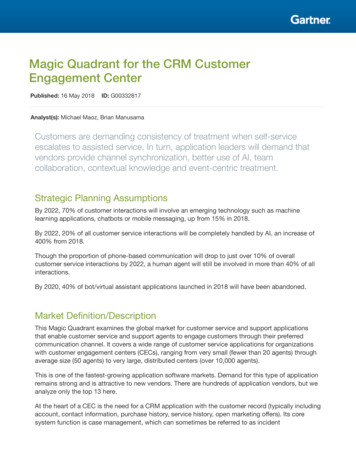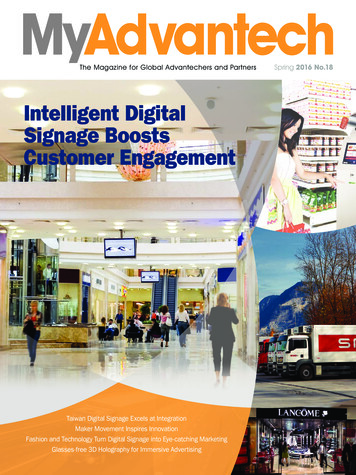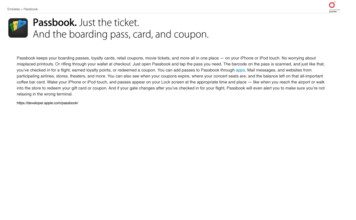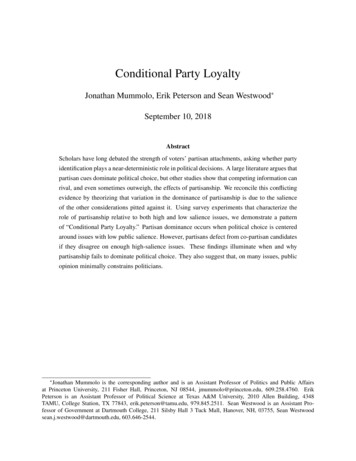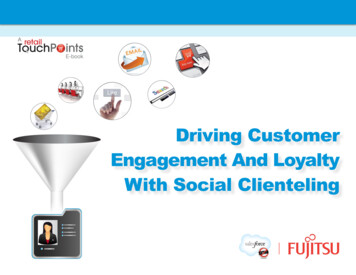
Transcription
AE-bookDriving CustomerEngagement And LoyaltyWith Social Clienteling
Retail success in today’s business climate demands dynamic, real-time action and reaction. Companies needto move as fast as their customers are moving – in a connected cross-channel environment that delivers aconsistent experience from the home to the store and beyond. Mobile devices and social media have givenbirth to portable product research, price comparisons and peer reviews. To succeed in the new era of socialretailing, smart merchants are adopting social clienteling strategies, designed to engage with customers inreal time in order to capture and retain the best customers, increase basket size and shopping frequency, andimprove overall loyalty.The days of retailers driving customer behavior are quickly slipping away. Consumers are in the driver’s seatand are clear-minded about the goals for their personal retail experience: they want value out of the productsthey buy (quality, price and convenience), they want their purchases to be relevant to their particular needs, andthey want to make purchases in the most time-efficient process.@The Social Divide: Customers and RetailersYour customers andemployees are social.What about yourcompany?@Driving Customer Engagement And Loyalty With Social Clienteling2
On-the-go with mobile devices and social media, today’sconsumers have real-time product information, reviews and storelocations at their fingertips. Retailers need to be present andengaged with customers wherever they are, and deliver a consistent“Retailers that failto introduce processesand technology to capitalize oncross-channel shopping acrosskey customer touch points will fallbehind their competitors.”message across all channels. So when a shopper turns off the PC,- Ed Thompson, Gartnerheads out the door with a smartphone, then drives downtown to visit astore, they are engaging with the same brand message throughout their journey.If retailers don’t achieve cross-channel consistency, they may be faced with immediate and serious risk of losingcurrent and future customers. Social media and mobile technology will be the culprits behind this demise.By 2015 as many as 75% of consumers, up from 25% in 2010, will tell their friends about bad experiencesusing social media, according to Ed Thompson from Gartner in the report Key Issues for Customer ExperienceManagement, 2011. Retailers simply cannot afford this type of bad press.@“Retailers that fail to introduce processes and technology to capitalize on cross-channel shopping acrosskey customer touch points will fall behind their competitors,” Gartner asserted in its Key Issues for Retail2011 report.But not only does the brand message need to be consistent across channels, engagement with individualcustomers must be personalized and customized for their needs. By collecting customer communications fromsocial media, as well as data, such as purchase history, wish lists, etc., from all other channels, retailers cancreate a social profile for each customer that can be used to develop one-to-one marketing strategies. Once@this perfect storm of customer experience strategies is achieved, then retailers can bank on increased walletshare and improved loyalty for the long term.Driving Customer Engagement And Loyalty With Social Clienteling3
Customer data enters the retailer’s sphere in a seemingly infinitenumber of combinations – from Google searches, Facebookposts, web site research, online and in-store transactions, callcenter communications, and store associate interactions. The trickTraditional clientelingis static. social clienteling isa dynamic view of the customerthat is shaped by in-store as wellas real-time online, mobile, andsocial media interactions.is to capture all the data, create a 360-degree view of each shopper –their social profile – then engage that shopper via her channels of choice.This new era of social clienteling differs from traditional clienteling in significant ways. Traditional clientelingis static – retail store associates may capture some profile and preference information directly from thecustomer in-store and save it primarily for reference; social clienteling is a dynamic view of the customer that isshaped by in-store as well as real-time online, mobile, and social media interactions.Q: how important are recommended products in the overall shopping experience?@@“Consumer Insights Into Multi-Channel Interactions: Practical Tools For Profitable Selling,” the e-tailing group, 2011Driving Customer Engagement And Loyalty With Social Clienteling4
Engaging with consumers at their channel of choice is a key element in the quest for overall cross-channelsuccess. Consumers are increasingly responding to personalized merchandising opportunities and productrecommendations. In fact, 39% of consumers say these tactics motivate them to purchase a product often toonce in a while, according to the e-tailing group in its 2011 study titled “Consumer Insights Into Multi-ChannelInteractions: Practical Tools For Profitable Selling.”“It’s encouraging to see that retailers are completely aware that the customer is driving the bus here,” addedSteve Rowen of RSR Research. “From a consumer perspective, the more free and actionable the flow ofproduct and brand information, the better.” Rowen noted that as many as 75% of retailers agree that socialmedia helps round out the retail consumer experience; and 72% say the customer is forcing them to have asocial media presence in the first place.To bring social clienteling to life, retailers need to facilitate service and solutions in the most convenient way –the way consumers are accessing more of their information today – through the cloud. For both retailers and@consumers, the cloud brings agility and speed; retailers also receive the added benefit of a low-cost alternativeto traditional, location-based solutions that are difficult to upgrade in this fast changing environment.This eBook will walk retailers through the process of initiating and enabling a social clienteling strategy, byhighlighting 4 key areas:@I.Social Clienteling DefinedII.Leveraging The Cloud To Enable Social ClientelingIII. Social Clienteling Meets Store OperationsIV.The Steps To Enabling Social ClientelingDriving Customer Engagement And Loyalty With Social Clienteling5
I. Social Clienteling DefinedThe social channel has become a vital component of shoppers’ daily communication and engagementactivities. Retailers need to embrace this growing trend and engage with shoppers through all meaningfulchannels. In fact, consumers are asking for exactly that type of interaction with their retail brands.Social clienteling facilitates real-time visibility into shoppers’ cross-channel and social media activity, enablingretailers to create a 360-degree view of each customer’s social profile through cloud-based data collection,storage and analysis. The social profile includes all transaction history across channels, customer contactdetails, their preferences and can include a number of data sources such as online browsing behavior,Facebook profile information, social media conversations and brand mentions, and marketing communicationssent and responses received.While traditional clienteling served retailers well in the past, it can be disjointed and siloed, not to mention@unresponsive. Retailers may collect information in the store, through catalog communications, via the callcenter or online, but those interactions are not coordinated to create a complete view of the customer. Socialclienteling is customer-centric and intelligent, and by using the cloud it facilitates real-time, low cost analysisand action.Social Clienteling versus Traditional Clienteling@Driving Customer Engagement And Loyalty With Social Clienteling6
II. Leveraging The CloudTo Enable Social ClientelingLet’s face it. Consumers are using their mobile phones on an increasing basis to conduct communications andtransact. As of June 2010, wireless penetration in the U.S. had reached 93%, according to CTIA. At the sametime the U.S. also ranked first globally in number of smartphones activated and number of mobile applicationsdownloaded.Mobile essentially creates a portable cloud for both consumers and retailers. Acknowledging the explosivegrowth of the use of mobile devices, smart retailers are meeting consumers within their portable cloud tocollect and analyze all brand-related activities and social communications.Within the cloud, retailers are able to create an optimum work environment that accesses third-party solutionson-demand, helping to maintain efficient business processes with a minimum financial investment.@Working with an experienced enterprise cloud computing provider and established third-party partners,retailers can build fully networked enterprises that facilitate communication among store personnel, betweenthe store and the shoppers and as a coordinated effort across all business processes.Fully networked enterprises – those that use collaborative technologies intensively to connect the internalefforts of employees and to extend the organization’s reach to customers, partners, and suppliers – “are notonly more likely to be market leaders or to be gaining market share but also use management practices thatlead to margins higher than those of companies using the Web in more limited ways,” reported the McKinsey@Global Institute in the Quarterly report titled The Rise of the Networked Enterprise: Web 2.0 Finds Its Payday.This premise is supported by real results. Among respondents who report using Web 2.0 technologies, 79%have achieved at least a 5% improvement in a range of business benefit metrics.Driving Customer Engagement And Loyalty With Social Clienteling7
Once fully networked, retail organizations can begin thework of engaging with customers socially, participating inconversations with consumers, and facilitating conversationsbetween customers. “ Retailers are waking up to an53% of Facebookusers have reached a retailer’sweb site from its Facebook page,and 35% of online shoppers said theywould be likely to make a purchasethrough Facebook.important new business challenge: how to serve as a facilitator ofsocial interactions around their brand Ultimately it reflects a move awayfrom ‘retailer as expert’ to ‘retailer as facilitator’ for consumers to reach the experts they deemimportant, whether family, friends or just ‘other people who bought this product,’” noted RSR’s Nikki Baird andSteve Rowen in the report After the Storm: Connecting With The New Online Consumer.Retailers are on their way. A significant number of retail organizations are now “providing more ways forconsumers to connect with each other through ourbrand,” according to RSR Research, up to 29% in 2010@from 8% in 2009. “This result is directly tied to the topLevel of Influence of Retailers’ Facebook Pages on thePurchase Decisions of US Online Buyers, Spring 2011% of respondentsbusiness challenge: keeping up with evolving consumerbehavior,” according to Baird and Rowen.1 influential 6.2%One significant way for consumers to connect through16.7%the brand is on Facebook. Retailers that create aFacebook presence are reaping the benefits. More than32.9%20% of online buyers found Facebook pages “influential”@or “extremely influential,” regardless of the channel where21.7%the transaction is completed, according to Compete inits study titled: “Spring 2011 Online Shopper Intelligence:Impact of Social Media on Retailing.”5 not at all influential22.5%Note: n 1,627 who visit retailer and/or consumer products companyFacebook pagesSource: Compete, “Spring 2011 Online Shopper Intelligence: Impact ofSocial Media on Retailing,” June 23, 2011www.eMarketer.comDriving Customer Engagement And Loyalty With Social Clienteling8
III. Social Clienteling Meets Store OperationsThe store is no longer a standalone fixture. Its success is impacted by the Internet, mobile and socialchannels, and vice versa. All applications, in and out of the store, must be social, mobile and open – able tointegrate with legacy and complementary applications with minimal effort. This turns a retail business into aSocial Enterprise that translates into increased sales, wallet share and loyalty.While eCommerce sales are growing, most purchases continue to be completed within the four walls. In Q12010, eCommerce accounted for only 4% of total U.S. sales, according to a Research and Markets study, atjust over 32 billion. That being said, an increasing number of shoppers are researching online or via mobiledevices prior to making purchases in-store.@Delight Your Customers through a Social EnterpriseEmployee SocialNetworks@Customer SocialNetworksSocialShoppingDriving Customer Engagement And Loyalty With Social Clienteling9
While 155 billion worth of consumer goods were bought online in 2009, a far larger portion of offline saleswere influenced by online research, according to the Forrester report “U.S. Online Retail Forecast, 2009 to2014,” which estimates that 917 billion worth of 2009 retail sales were “Web-influenced.” Online and Webinfluenced offline sales combined accounted for 42% of total retail sales and that percentage will grow to 53%by 2014, when the Web will be influencing 1.4 billion worth of in-store sales.But that prediction could be over-reaching if retailers neglect the cross-channel customer experience. In 2009,according to Forrester, only 61% of consumers who crossed over from online to in-store were satisfied withtheir buying experience, compared to 82% for those who completed their purchases online.Further, according to a recent Consumer Reports’ survey, 65% of U.S. customers are “tremendously annoyed”by rude salespeople and 64% of respondents said that they had left a store in the previous 12 monthsbecause of poor service.@In order for retailers to do a better jobCIOs Surveyed on Tablet Usageappealing to all consumers in their physicalstores, they need to apply the conceptsof social clienteling and create an overallSocial Enterprise across all channels of theirbusinesses. What that means inside thestore is the need to implement advancedin-store technologies that integrate store@operations with online, mobile, catalogand contact center operations. Many retailCIOs already are responding to this needMorgan Stanley, “Tablet Demand and Disruption”, February 14, 2011.Driving Customer Engagement And Loyalty With Social Clienteling10
With an integrated SocialEnterprise, store managers canfind out what products sold by SKU perby completely changing their view on armingday, calculate real-time out-of-stock andemployees with tablets. As many as 51% of CIOsin-stock positions, and complete anin all industries have purchased tablets for theiraccounting of store personnelemployees in 2011, compared to 71% who didn’tat any time of day.allow tablet use in 2010, according to a 2011 MorganStanley report titled: “Tablet Demand and Disruption.”Tapping into the integration capabilities cloud-based platforms, retailers can bring socialclienteling and best-in-class store operations into the store – from pricing and promotions to shipping, backorders, loyalty, returns and POS. Additionally, to be most effective these processes must be deliverablevia mobile technology, so retail managers and store associates can have their finger on the pulse of storeoperations anytime and anywhere.With an integrated Social Enterprise, store managers can find out what products sold by SKU per day,@calculate real-time out-of-stock and in-stock positions, and complete an accounting of store personnel atany time of day. In the past, store managers may have received some of this information by email, some inthe POS terminal and other information on the office PC. Now managers can run the entire operation from acentral office manager work station on a mobile device. All this information can be consolidated with loyalty,purchase and social communication information to create more efficient store operations and a completesocial profile of each customer.Other tools also can help facilitate the in-store Social Enterprise, such as an internal collaboration system that@allows store managers to communicate with peers in different parts of the country in real time, for example todetermine whether a promotion is working or a display is successful.Driving Customer Engagement And Loyalty With Social Clienteling11
IV. Steps To Enabling Social ClientelingA new concept for many retail organizations, social clienteling can be the key that opens the doors to a fullyintegrated Social Enterprise. Retailers can begin this journey with the following three steps:1. Develop a Cross-Channel Social Profile for Every Customer.This can be achieved using a profile formula, accessible throughout the retail organization that createsindividual profiles based on customers’: DemographicsDevelop a Social Customer Profile Brand and Item Preferences Purchase History@ Browsing History Wish Lists Service Requests Campaign Participation Social Network Dialog@Delighting customers is knowing who they areand what they “like.”Driving Customer Engagement And Loyalty With Social Clienteling12
To be most effective, this profile should be updated in real time as the customer interacts with the retailorganization. Customers also should be aware of and have access to their own personal profiles via theirsmartphones.2. Empower In-Store and Call Center EmployeesTo be effective, the social profiles must be consistent and updated in real time throughout the retailorganization. That means providing store managers, store associates and call center staff the ability to accessand update the social profiles and the operations data that will support each customer.Further, employees must have real-time access to customer information at the point of customer interaction,not just at the POS. By implementing a private, internal social network solution, store associates, call centeremployees and managers can collaborate across stores and channels in real-time to serve the immediateneeds of the customer and also share best practices from store to store and region to region.@3. Listen, Engage and Act by Connecting the Retail Organization to Relevant Public Social NetworksShoppers are listening to and engaging with peers and other shoppers on social networks, and they aremaking purchase decisions based on those relationships. Retailers need to join that conversation andestablish relationships with their customer base.It is not enough to simply collect data on the items customers are buying and how often they are shopping;retail organizations must develop relationships that encompass the whole customer – including her@preferences, likes and dislikes. With this information in hand, retailers can serve their customers and developlong-term loyalty.Driving Customer Engagement And Loyalty With Social Clienteling13
To that end, smart retailers already have developed fan pages and opt-in applications on Facebook. Further,on the heels of the first JCPenney industry-leading enterprise, retail organizations are bringing shopping to theshoppers by opening Facebook storefronts.Once engaged with customers within social networks, the next step for retailers is tracking customer dialogand marketing to customers within the social channel. By implementing a social media monitoring andengagement solution, retail organizations can listen to what people are saying about their company andbrand; react to negative comments and feedback before they become viral; uncover the key influencerswho can make or break your brand in the social realm; benchmark the competition; and initiate customerservice outreach.Retail brands can provide special offers to Facebook fans, publish event details, introduce new products andsolicit feedback on specific items.@Shopper fans also should be able to create wish lists within their social profile. And, while visiting
Driving Customer Engagement And Loyalty With Social Clienteling 2 @ @ Retail success in today’s business climate demands . real time in order to capture and retain the best customers, increase basket size and shopping frequency, and . only more likely to be market leaders or to be gaining market shar
